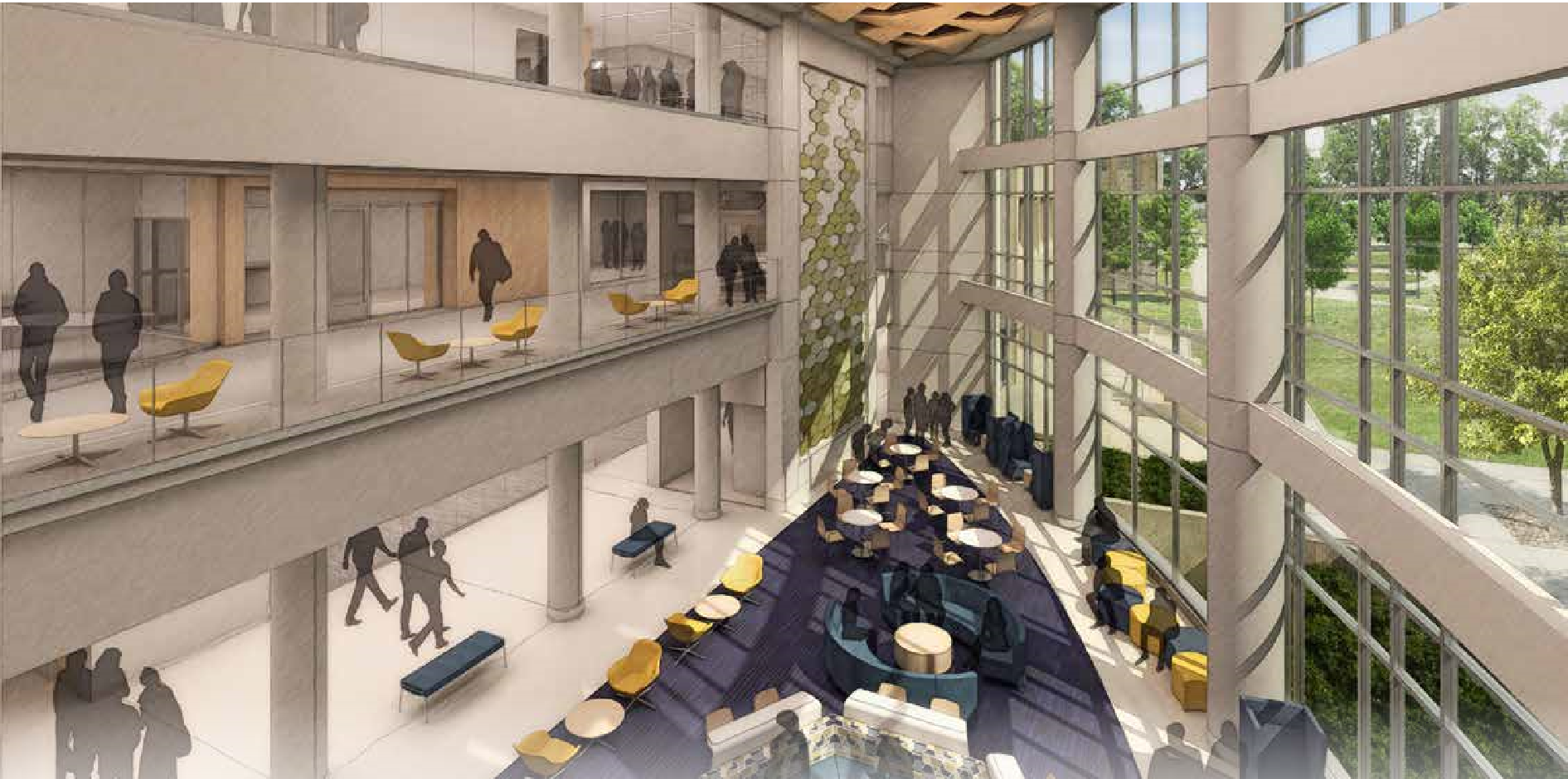The atrium will be part of Phase I of Butler’s sciences renovation and expansion plan. It is the largest investment made by the school in its history. Rendering courtesy of Butler University.
JESSICA LEE, MEGHAN STRATTON | EDITOR-IN-CHIEF, MANAGING EDITOR | jelee2@butler.edu, mrstratt@butler.edu
The Butler Board of Trustees granted approval for a $100 million renovation and expansion project toward the sciences during their meeting on June 7. It is the largest investment made by the school.
The construction will happen in three phases, with Phase I and II expected to start soon according to a Butler University press release.
Phase I will add 44,000 square feet, which will serve as a central ground for Butler’s science program, connecting Gallahue Hall and the Holcomb Building. This space will include classrooms, study areas and research and teaching labs dedicated to chemistry, astronomy, physics, dual-degree engineering and psychology programs. There will also be a 13,140-square-foot atrium.
An example of a biology lab after the renovations. Rendering courtesy of Butler University.
Phase II will involve the renovation of Holcomb, as the Andre B. Lacy School of Business moves to its new building this upcoming fall. New classrooms, labs and collaborative work spaces will be added and repurposed toward physics, psychology and neuroscience programs.
These first two phases will take an estimated 18 months to complete. By completing the Holcomb Building first, classes can then move into the new rooms and labs as Phase III starts.
In Phase III, Gallahue Hall will see its first update since 1973. The renovation will also include new classrooms, labs and collaborative work spaces for biology, molecular biology, biochemistry and chemistry programs, as well as a suite for the Center for Urban Ecology.
Umayr Shaikh, a rising junior Spanish and chemistry double major, said he, along with some science professors he has spoken to, are very excited about the plan. He said he would love to see more chemical safety hoods in classrooms, which would be especially helpful in upper level science courses.
“The fact that students will have more resources that can be easily applied will foster growth,” Shaikh said, adding that he learns better when he’s able to see what’s being taught, like in a lab.
Jay Howard, dean of the College of Liberal Arts and Sciences, has been a part of the original planning committee since 2011.
“It’s certainly very exciting,” Howard said. “We’re all delighted that the trustees have given the green light to start the project. It’s been a long time coming.”
Before the project was approved, Butler had to take multiple steps, including anticipating its enrollment growth.
Over the past decade, enrollment in science programs has increased 70 percent. Including students in the College of Pharmacy and Health Sciences, two in five students are science majors at Butler.
Howard said due to the growth of sciences, students and faculty are “crowded elbow-to-elbow,” which is largely why the sciences are being renovated instead of Jordan Hall.
“By no means are we saying Jordan Hall doesn’t need attention, but in terms of where the enrollment growth at Butler is happening, that’s logically where you have to prioritize,” Howard said.
There has already been $27.5 million raised toward the philanthropy goal of $42 million. Major donors include Richard M. Fairbanks Foundation, Frank Levinson ’75, Craig Fenneman ’71 and Mary Stover-Fenneman, Lynne Zydowsky ’81, Josh Smiley, Katie and Len Betley, Lou and Laura Glazer, Jane and Robert Wildman, and Dick and Billie Lou Wood. A major gift at Butler is $50,000.
There are several naming rights opportunities for different areas of the new building, ranging from $100,000 to $500,000.
The rest of the $100 million will be raised through selling bonds.
“This is a significant and historic step forward as Butler continues to transform education for the needs of students and employers in the 21st century,” President Jim Danko said in the press release.
In addition to visiting other universities’ facilities for ideas, the planning team visited Eli Lilly, Roche and Corteva to get an idea of what labs at innovative research companies look like.




